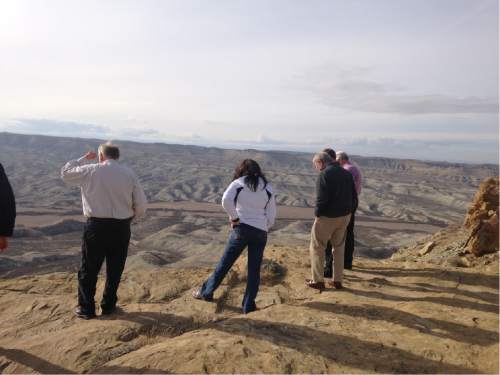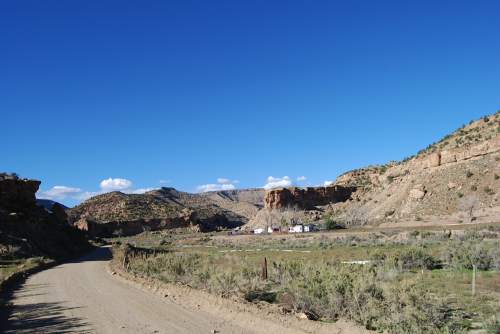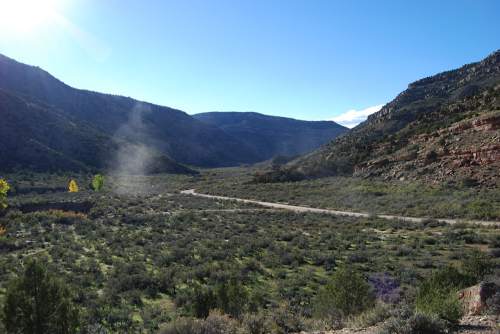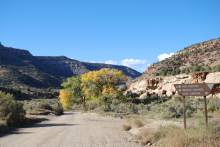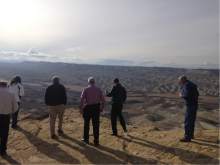This is an archived article that was published on sltrib.com in 2014, and information in the article may be outdated. It is provided only for personal research purposes and may not be reprinted.
For fellow legislators touring the remote Book Cliffs, Sen. Kevin Van Tassell, R-Vernal, draws an imaginary map on his hand to outline a dream that he says could drive more tourists into the Uinta Basin and Utah.
"You could call it the national parks highway," he says.
"It would start at Yellowstone and go to Grand Teton, Flaming Gorge, Dinosaur, the Book Cliffs, Arches, Canyonlands and the Four Corners area," with its Hovenweep and Natural Bridges national monuments, he says tracing a straight line down his hand.
The road could also extend straight through Arizona to Canyon De Chelly National Monument and Petrified Forest National Park. "There's not a lot of places where national parks line up like that on one road. Think of the attraction," Van Tassell says.
Almost all the pieces are in place for such a national parks highway, he adds, except one big hole — a 40-mile stretch of challenging (and controversial) pavement in a rugged part of Grand County in the Books Cliffs.
Environmentalists worry a paved road there could damage proposed wilderness areas and they see the national parks highway proposal as a ruse to allow subsidizing oil companies with a road that would mostly benefit them.
"The largest uninterrupted wilderness area in the United States is the Book Cliffs area. And roads that even touch that area are going to impact it greatly," said Mary McGann, a newly elected Grand County Council member.
The national parks highway idea has other obstacles, too. It would require persuading state and federal agencies to take over a new $60 million Uintah County highway (which is giving impetus to talk about a road connecting parks), and renumber other routes into one uniformly named highway.
"If we finish the road, it should be U.S. 191," which is already the designation for most of the route, Van Tassell says. His envisioned changes would include erasing the U.S. 191 designation where it veers too far from national parks, such as in Indian Canyon between Price and Duchesne.
To promote the idea, Van Tassell recently took several legislators — mostly members of the Transportation Interim Committee, on which he serves as Senate chairman — on a tour to some of the remote areas that are sticking points in the plan.
—
New road • Van Tassell's tour covered all 45 miles of the newly paved Seep Ridge Road, built by Uintah County with $60 million from community impact funds from oil and gas royalties. It stretches from south of Ouray to the Grand County line.
The new county road is wider and nicer than most other federal and state highways in the Uinta Basin, including the major U.S. 40 and U.S. 191. It has 15 miles of climbing or passing lanes.
"We overbuilt Seep Ridge Road," Van Tassell says, to meet federal and state road standards in hopes that they will take it over someday as a key part of the national parks highway. In exchange, the county could take over other more minor state routes.
Before Seep Ridge was paved, traveling the old shale-covered road there to the Grand County line took 4.5 hours from Vernal. Now it takes 90 minutes, says Uintah County Commissioner Mark Raymond.
Van Tassell adds that whenever the county graded the old unpaved road, it tended to sharpen the shale there, turning it almost into arrow points. "It was a good day if you only got one flat tire instead of two."
Carlos Braceras, executive director of the Utah Department of Transportation, acknowledges, "It's a nice looking road." But he adds, "It sticks out there a bit, doesn't it — that big wide road" with little traffic now. A recent study found that annual daily traffic on the road last June was only 117 vehicles, 70 percent of them oil-field trucks.
Van Tassell says the road has helped the oil and gas industry to service its myriad wells in the area, and also truck out some crude oil. Experimental oil shale and oil sands mines are also there, and the road is key to the industry if they start producing large amounts.
Finishing the 40 miles to Interstate 70 through Grand County could provide a shorter route to the railroad and freeway to ship crude oil to refineries.
Jeff Hartley, vice president of the Red Leaf Resources oil shale company, also told legislators that completing the road could help it employ miners from Emery and Carbon counties at its Uintah County surface mine. He says it could give trained miners — from where many coal mines have closed — a one-way commute of less than two hours.
—
Controversy • But Grand County is split over paving that final 40 miles, says County Council Chairman Lynn Jackson.
County-owned gravel roads have traversed that area since the 1970s, built to access some oil and gas wells, but they are around proposed wilderness areas.
Because Rep. Rob Bishop, R-Utah, had been working on legislation that could designate some large-scale wilderness areas there, Jackson says, "We figured that before we make any decisions, we should take another look" at routes that possibly may be paved.
A preliminary analysis was completed last summer, and says it is feasible to build a paved road to state standards to I-70 either through Hay or East canyons. It would link to I-70 near Cisco, and also allow a direct route from there to Moab on State Road 128, which follows the Colorado River.
The study estimates the cost between $110 million and $199 million. The county has since started a more in-depth economic analysis, which Jackson says is due next summer.
In Grand County Council elections this year, candidates who supported preservation in the county over helping the oil industry won all the races, says McGann, who defeated an incumbent. She says that shows most residents don't support such things as paving a road through the Book Cliffs.
The proposed highway, McGann charges, "is a smokescreen for subsidizing oil companies more than it is for a national park highway."
She adds, "If the oil companies felt it was viable, they would do it. They would pay for it. I don't think taxpayer dollars should go to subsidize oil companies."
Braceras, the UDOT director, says such worries could prevent paving. "We can't minimize the challenges of a road through that geography. There is a [dirt] road there, but not much of a road. The engineering challenges can always be solved with money. But the environmental challenges might not."
He adds, "We are looking at an area that is pretty remote and pristine. Would a road be a negative impact? Probably some people would see it that way. I would reserve judgment."
"There won't be unanimous support or opposition in the county to the project," Jackson says. "We're tying to take it one step at a time. If the study shows it is good and the state is interested, then we will see where we go from there."
Jackson, meanwhile, lists potential benefits from the road that could be considered.
He says it would help develop new oil and gas wells in Grand County, help more easily deliver product from existing wells, and give an alternate route for oil out of the Uinta Basin. "That would create jobs and help the economy."
Also, "It could help tourism," he adds. Jackson says, for example, many foreign tourists fly to Las Vegas to do a grand tour of the Grand Canyon, Zion, Bryce Canyon, Arches and Canyonlands, "But they don't have easy access to parks in the north like Yellowstone," or even Dinosaur National Monument. A paved road would change that.
But McGann says tourism in Grand County "is already thriving," and may even be nearing the saturation point. She said even some recreation groups opposed a Book Cliffs paved road, which gives her pause.
—
New attraction? • Van Tassell and Raymond, the Uintah County commissioner, say a national park highway could help Uinta Basin's tourist industry.
Raymond told legislators on the tour that the Book Cliffs "has its own kind of beauty, but is not as spectacular as the red rocks" national parks farther south.
"If you need a place to produce oil and gas, and we do, this is probably it," he says pointing at a sage desert landscape dotted with wells, interspersed with juniper forests.
But it has some spectacular views, and wildlife. The tour of legislators saw herds of deer, a flock of turkeys and some wild horses — but didn't see the bison that Raymond says also range there.
McGann calls the Book Cliffs "the Serengetti of Utah" with miles and miles of undisturbed wilderness, and she worries a new highway would harm it.
Lawmakers stopped at a dazzling overlook just off Seep Ridge Road with views of distant canyons and plateaus stretching for miles, reminiscent of vistas from such places as Canyonlands or the Grand Canyon.
If the area were connected directly to Moab, a hotspot for mountain biking, Van Tassell says he could see that spread to the Book Cliffs.
"What a bicycle Mecca. You could come from Moab" following the Colorado River, "then ride up over the Book Cliffs. People could bicycle all the way to Yellowstone, if they wanted to," he says.
Van Tassell and Raymond are quick to say the decision of whether Grand County extends the road is up to residents there. Still, they are trying to point out potential benefits of a national parks road — joined by officials from Uintah, Duchesne, Daggett, Emery, Carbon and San Juan counties.
Braceras says Uinta Basin officials often remind him of their vision whenever he sees them in hopes that UDOT will help extend the road. But he says, "We don't have any plans to do that right now."
"It's not going to happen tomorrow," Van Tassell acknowledges. "But it's certainly an opportunity."
#LeeHDavidson


